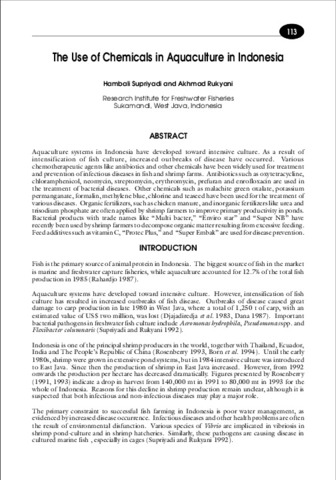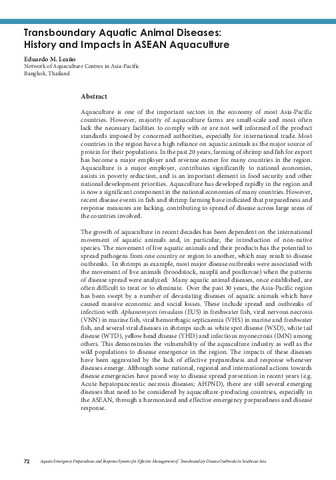The use of chemicals in aquaculture in Indonesia
- Global styles
- MLA
- Vancouver
- Elsevier - Harvard
- APA
- Help

Date
2000Page views
7,676ASFA keyword
chlorophylls 
shrimp culture
aquaculture regulations
drug resistance
bacterial diseases
pond culture
therapy
disease control
environmental impact
antibiotics
aquaculture
control methods
feed composition
fertilizers
intensive aquaculture
infectious diseases
fish diseases
pollutants
disease prophylaxis
chemical pollutants

shrimp culture

aquaculture regulations

drug resistance

bacterial diseases

pond culture

therapy

disease control

environmental impact

antibiotics

aquaculture

control methods

feed composition

fertilizers

intensive aquaculture

infectious diseases

fish diseases

pollutants

disease prophylaxis

chemical pollutants

Metadata
Perlihat publikasi penuh
Share
Abstract
Aquaculture systems in Indonesia have developed toward intensive culture. As a result of intensification of fish culture, increased outbreaks of disease have occurred. Various chemotherapeutic agents like antibiotics and other chemicals have been widely used for treatment and prevention of infectious diseases in fish and shrimp farms. Antibiotics such as oxytetracycline, chloramphenicol, neomycin, streptomycin, erythromycin, prefuran and enrofloxacin are used in the treatment of bacterial diseases. Other chemicals such as malachite green oxalate, potassium permanganate, formalin, methylene blue, chlorine and teaseed have been used for the treatment of various diseases. Organic fertilizers, such as chicken manure, and inorganic fertilizers like urea and trisodium phosphate are often applied by shrimp farmers to improve primary productivity in ponds. Bacterial products with trade names like “Multi bacter,” “Enviro star” and “Super NB” have recently been used by shrimp farmers to decompose organic matter resulting from excessive feeding. Feed additives such as vitamin C, “Protec Plus,” and “Super Embak” are used for disease prevention.
Suggested Citation
Supriyadi, H., & Rukyani, A. (2000). The use of chemicals in aquaculture in Indonesia. In J. R. Arthur, C. R. Lavilla-Pitogo, & R. P. Subasinghe (Eds.), Use of Chemicals in Aquaculture in Asia: Proceedings of the Meeting on the Use of Chemicals in Aquaculture in Asia, 20-22 May 1996, Tigbauan, Iloilo, Philippines (pp. 113-118). Tigbauan, Iloilo, Philippines: Aquaculture Department, Southeast Asian Fisheries Development Center.
Type
Conference paperISBN
9718511490Koleksi
Related items
Showing items related by title, author, creator and subject.
-
Country status of aquatic emergency preparedness and response systems for effective management of aquatic animal disease outbreaks in Myanmar
Oo, Kyaw Naing; Cho, Yi Yi (Aquaculture Department, Southeast Asian Fisheries Development Center, 2019)Myanmar is one of the OIE members and the Department of Fisheries (DoF) is highly concerned with transboundary aquatic animal pathogens. Therefore, the Aquatic Animal Health & Disease Control Section has already been ... -
Transboundary aquatic animal diseases: History and impacts in ASEAN aquaculture
Leaño, Eduardo M. (Aquaculture Department, Southeast Asian Fisheries Development Center, 2019)Aquaculture is one of the important sectors in the economy of most Asia-Pacific countries. However, majority of aquaculture farms are small-scale and most often lack the necessary facilities to comply with or are not well ... -
Emergency response to emerging diseases: TiLV in tilapia
Senapin, Saengchan (Aquaculture Department, Southeast Asian Fisheries Development Center, 2019)Tilapia lake virus (TiLV) is a novel RNA virus resembling Orthomyxovirus. It has been recently re-classified to Tilapia tilapinevirus species, under Tilapinevirus genus, Amnoonviridae family (ICTV, 2018). Since the first ...




